As President Joe Biden’s student debt cancellation plan is held up in court, new polling finds that student debt relief was a major driver of votes in this year’s midterm election — especially among young voters, who were crucial to delivering wins for Democrats in November.
Among 1,500 midterm voters polled by the Student Borrower Protection Center and Seven Letter Insight after the general election in November, just over half (51 percent) said that student debt relief was either the only reason they voted or was very or somewhat motivating to their decision to go to the polls, with 25 percent saying it was very motivating.
The issue was especially important for young voters, the polling found. Among voters aged between 18 and 29 who cast a ballot, 77 percent of voters said that student debt relief was a motivating factor, with 47 percent saying it was very motivating and 12 percent saying it was the only reason they voted. The proportion of young voters who felt motivated to vote because of debt relief is even higher than the proportion of voters with student debt who felt the same, at 60 percent for the latter group.
The poll results line up with previous findings. In September, Data for Progress found that 46 percent of likely voters said they were more likely to vote in the midterm elections because of Biden’s student debt cancellation plan.
The results demonstrate the importance of student debt relief to voters and suggest that canceling student debt is a politically savvy move for Democrats.
The results could also suggest that Biden should heed activists’ calls to pursue student debt relief more aggressively, through a different avenue than the one he used for the plan that’s set to come before the Supreme Court next year; his plan to cancel up to $10,000 of student debt for borrowers or $20,000 for Pell Grant recipients may have helped to deliver Democrats a better-than-expected result in the midterms, but borrowers may have that relief yanked out from under them if the Supreme Court strikes down the plan in its current form.
Though student debt relief was once regarded as a fringe leftist idea in establishment political circles — and is still most fiercely advocated for by the left — the issue clearly weighs heavily among the public, especially young people.
Research has shown that young people are more economically disadvantaged than previous generations were at the same age, and that young people are currently driving a leftward shift among the electorate.
Young people are also more likely than previous generations to be burdened with student debt, as the cost of college tuition has skyrocketed in recent decades and wages have remained stagnant, even while more jobs require college degrees. Since 2006, the total amount of credit card and other common forms of debt owed by the public has remained relatively stagnant — but the amount of student debt collectively owed in the U.S. has jumped from $500 billion to $1.75 trillion, according to Federal Reserve statistics.
Previous polls have confirmed that student debt cancellation is popular among the public. A Data for Progress poll from September found that 55 percent of likely voters support Biden’s plan, including 88 percent of Democrats and 76 percent of student loan borrowers.
We’re not backing down in the face of Trump’s threats.
As Donald Trump is inaugurated a second time, independent media organizations are faced with urgent mandates: Tell the truth more loudly than ever before. Do that work even as our standard modes of distribution (such as social media platforms) are being manipulated and curtailed by forces of fascist repression and ruthless capitalism. Do that work even as journalism and journalists face targeted attacks, including from the government itself. And do that work in community, never forgetting that we’re not shouting into a faceless void – we’re reaching out to real people amid a life-threatening political climate.
Our task is formidable, and it requires us to ground ourselves in our principles, remind ourselves of our utility, dig in and commit.
As a dizzying number of corporate news organizations – either through need or greed – rush to implement new ways to further monetize their content, and others acquiesce to Trump’s wishes, now is a time for movement media-makers to double down on community-first models.
At Truthout, we are reaffirming our commitments on this front: We won’t run ads or have a paywall because we believe that everyone should have access to information, and that access should exist without barriers and free of distractions from craven corporate interests. We recognize the implications for democracy when information-seekers click a link only to find the article trapped behind a paywall or buried on a page with dozens of invasive ads. The laws of capitalism dictate an unending increase in monetization, and much of the media simply follows those laws. Truthout and many of our peers are dedicating ourselves to following other paths – a commitment which feels vital in a moment when corporations are evermore overtly embedded in government.
Over 80 percent of Truthout‘s funding comes from small individual donations from our community of readers, and the remaining 20 percent comes from a handful of social justice-oriented foundations. Over a third of our total budget is supported by recurring monthly donors, many of whom give because they want to help us keep Truthout barrier-free for everyone.
You can help by giving today. Whether you can make a small monthly donation or a larger gift, Truthout only works with your support.
